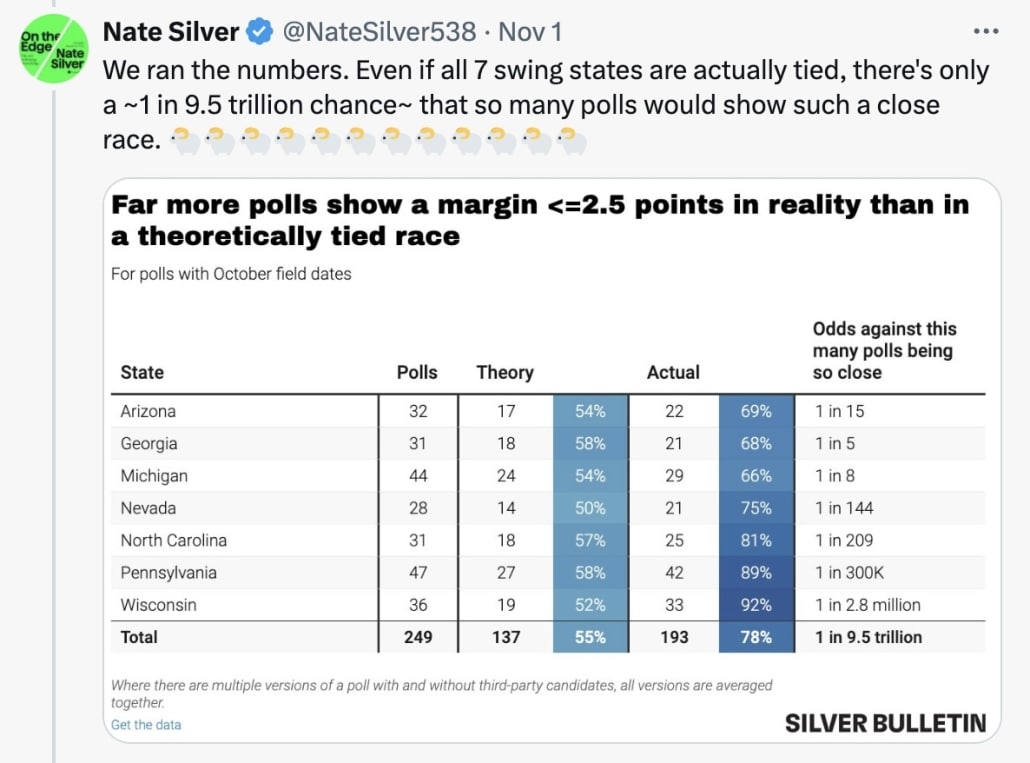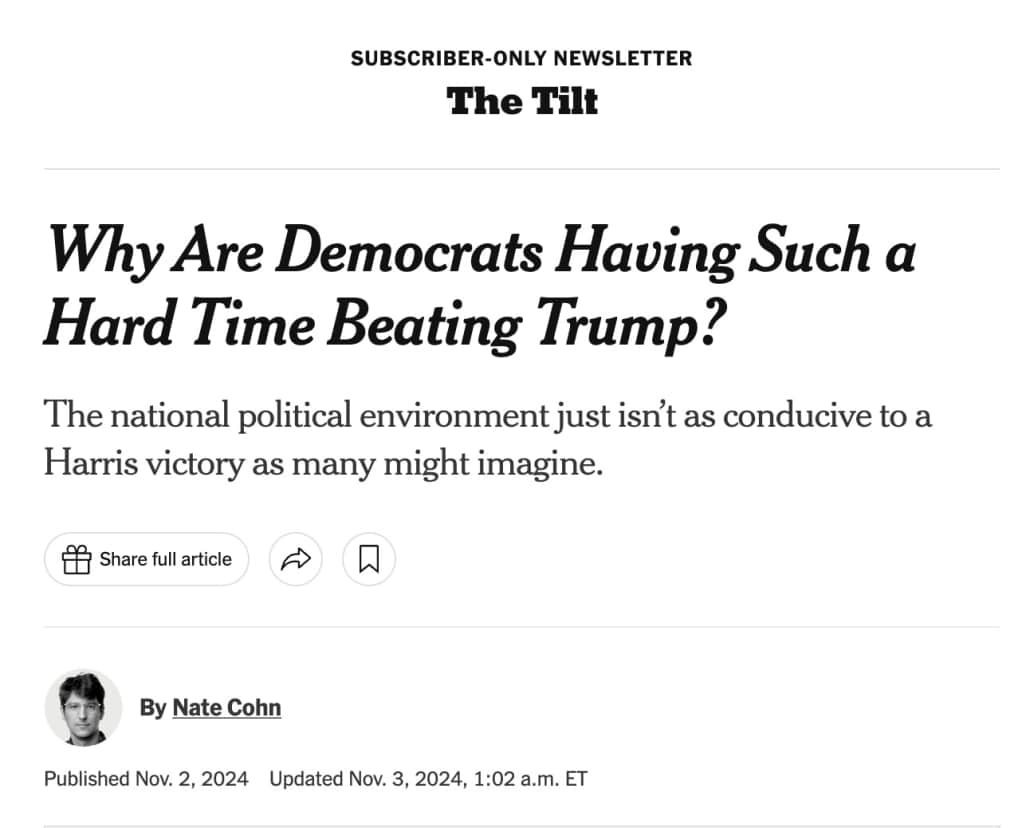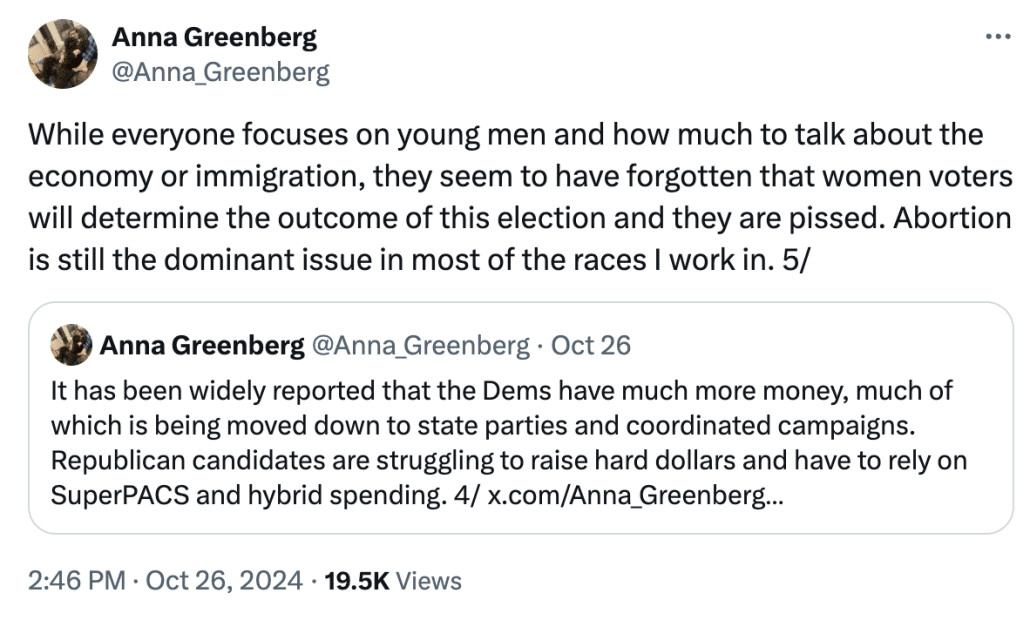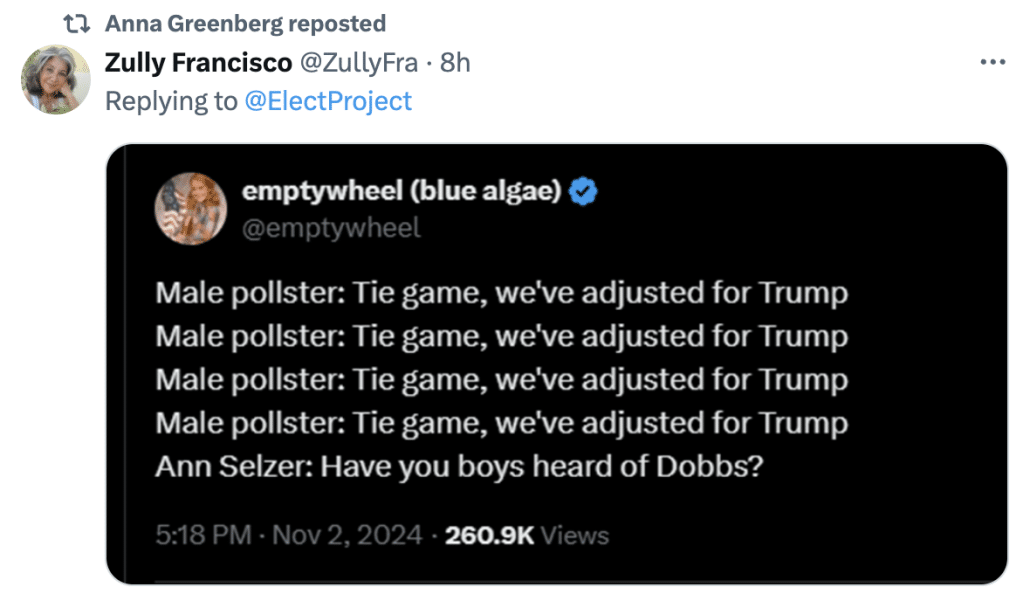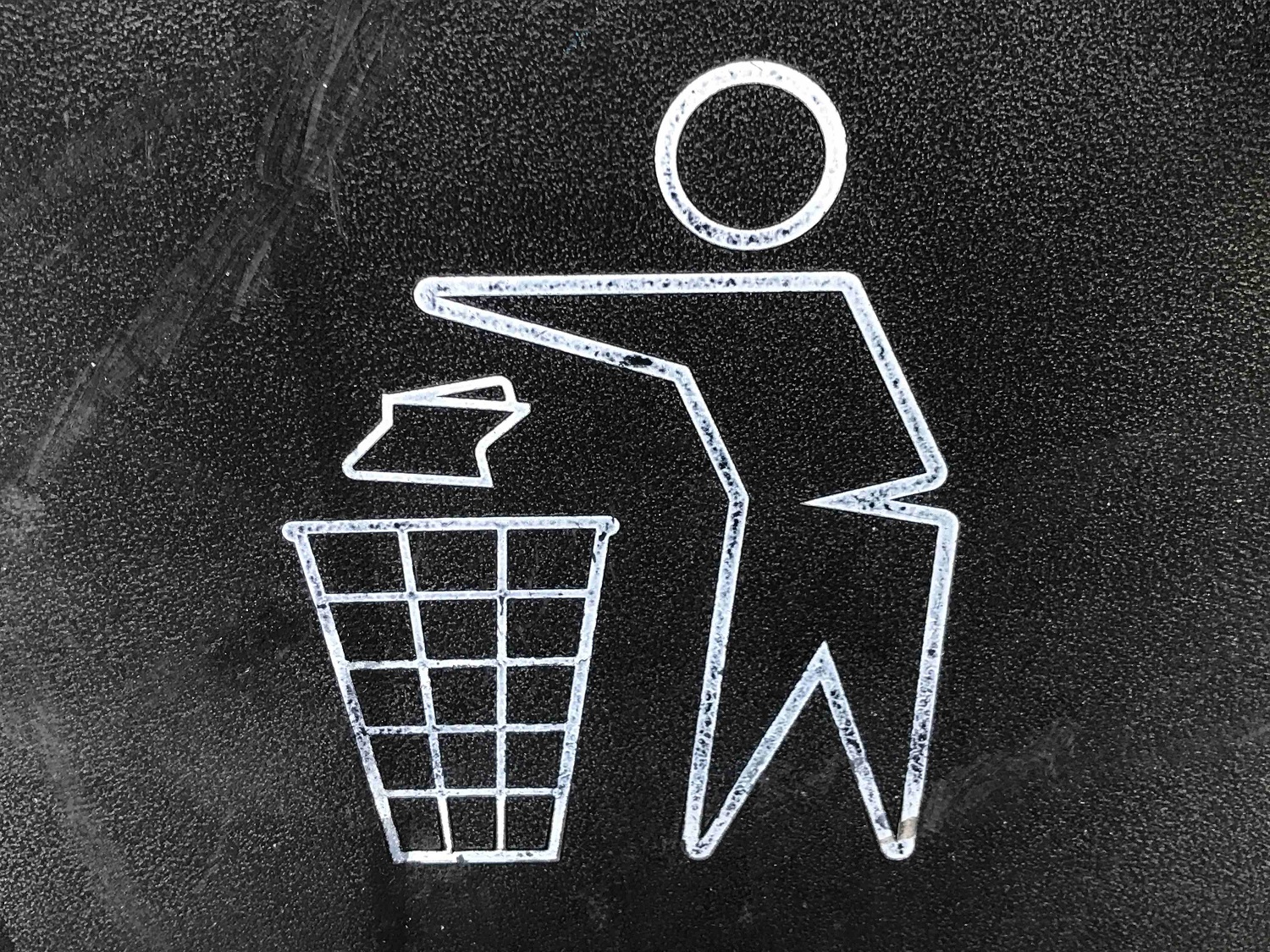Male Pollsters Shocked — Shocked!! — When a Woman Pollster Discovers Women Voters
On Friday, Nate Silver tweeted and substacked a piece declaring that there must be herding going on in the casino.
His substack analysis didn’t acknowledge, however, that this herding was going on in his casino.
Now granted, our forecast is close too. But it’s based on polling averages: dozens of polls have been released in each of these states over the past month. That greatly increases the sample size. Collectively, they’ve surveyed about 230,000 voters.
By contrast, the median sample size in individual polls in these states is 800 voters. In a 49-49 race in a poll of 800 people — assuming 2 percent goes to third parties — the theoretical margin of error for the difference between Trump and Harris is ±6 points. If that sounds higher than you’re expecting, that’s because the margin of error that’s usually reported in polls is only for one candidate’s vote share. For instance, in a poll of 800 people, Trump’s margin of error is about ±3 points, as is Harris’s. However, basically every vote that isn’t a vote for Trump is a vote for Harris. If Trump gets 52 percent of the vote instead of 49, that implies Harris will receive 46 percent.1 So the margin of error on the difference separating Trump and Harris is ±6.
What this means is that if pollsters are doing honest work, we should see a lot more “outliers” than we do — even if people love to complain about them on Twitter.
In our database as of this afternoon’s model run, there were 249 polls in the seven battleground states that met Silver Bulletin standards and did at least some of their fieldwork in October.2 How many of them showed the race in either direction within 2.5 percentage points3, close enough that you could basically call it a tie?
Well, 193 of them did, or 78 percent. That’s way more than you should get in theory — even if the candidates are actually exactly tied in all seven states, which they almost certainly aren’t.
The reason we’re seeing this herding is because Nate Silver has spent 16 years training pollsters to herd. It probably makes things worse that polling has become far more difficult, far more expensive, and far more important in shitty campaign coverage (not least because of Nate Silver). The herding is happening because, thanks to the early but not more recent success of Nate, political operatives know they can create a reality in poll averages.
Well, ask and you shall receive, Nate, because Ann Selzer doesn’t herd. Last night, the Iowa pollster surprised everyone with a poll showing Kamala Harris ahead in Iowa.
A new Des Moines Register/Mediacom Iowa Poll shows Vice President Harris leading former President Trump 47% to 44% among likely voters just days before a high-stakes election that appears deadlocked in key battleground states.
The results follow a September Iowa Poll that showed Trump with a 4-point lead over Harris and a June Iowa Poll showing him with an 18-point lead over Democratic President Joe Biden, who was the presumed Democratic nominee at the time.
“It’s hard for anybody to say they saw this coming,” said pollster J. Ann Selzer, president of Selzer & Co. “She has clearly leaped into a leading position.”
As Selzer describes, this effect is driven by older women voters.
The poll shows that women — particularly those who are older or who are politically independent — are driving the late shift toward Harris.
“Age and gender are the two most dynamic factors that are explaining these numbers,” Selzer said.
Independent voters, who had consistently supported Trump in the leadup to this election, now break for Harris. That’s driven by the strength of independent women, who back Harris by a 28-point margin, while independent men support Trump, but by a smaller margin.
Similarly, senior voters who are 65 and older favor Harris. But senior women support her by a more than 2-to-1 margin, 63% to 28%, while senior men favor her by just 2 percentage points, 47% to 45%.
Nate promptly set to work describing how brave it was for Selzer to release this because a gambling market Nate has helped to create says she’s wrong.
Releasing this poll took an incredible amount of guts because — let me state this as carefully as I can — if you had to play the odds, this time Selzer will probably be wrong. Harris’s chances of winning Iowa nearly doubled in our model from 9 percent to 17 percent tonight, which isn’t nothing. Polymarket shows a similar trend, moving from 6 percent to 18 percent after the survey. But that still places Harris’s odds at around 5:1 against.
While I don’t pay for Nate Silver’s gambling market, he appears to have gone on to argue that what Selzer is measuring is inflation, not just — as Selzer explained — big movement from women.
Meanwhile, that Other Nate, Nate Cohn, released this column, in what former pollster Adam Carlson described as “rough timing.”
Other Nate then went on to point to things that followed the pandemic but which are either now in the past or which polls always reflected a misunderstanding on the part of voters.
[T]he events that followed the pandemic took a serious toll on the case for liberalism, whatever the precise merits of the arguments. Inflation and high interest rates could be blamed on high government spending stimulating excessive demand. High gas prices could be blamed on suspending drilling permits and the termination of the Keystone pipeline project. A surge of migrants could be blamed on the administration’s looser border policy, which became politically untenable; homelessness, crime and disorder made the case for “law and order.”
From there, Other Nate made some false claims, such as that Harris — whose plan to include home health care in Medicare has been ignored by the press, and who mentions plans to increase the child tax credit and mortgage assistance in every stump speech — had moved away from populism.
The traditional Democratic program to expand the social safety net has played a diminished role in the campaign. In her speech at the Democratic convention, Ms. Harris didn’t mention the unfinished business of Obama-Biden era liberalism: paid family leave, an expanded child tax credit, student loan forgiveness, universal pre-K or free community college.
And Other Nate claimed that polls have shown that Trump does better on the issue that is most important to voters votes.
If there’s any poll question that captures the swing toward a more conservative environment, it’s the question of which party (or candidate) would do the best on the issue that’s most important to your vote. All cycle, polls have shown Republicans and Mr. Trump with an advantage on this measure.
Other Nate didn’t mention that on the one that matters to most people, the economy, Harris has caught up to Trump.
Crazier still, Other Nate didn’t mention that for those who say abortion is the most important, Harris always wins. He simply disappeared abortion in his claim that voters think Trump would do better on all issues that are most important to them.
The other day, I hoped that someone with interns would review the Other Nate’s statements about this race — but hell, do it for First Nate, too — to see whether his mentions of polling adjustments adjust for the Dobbs effect, the recent trend in which, with one exception, polls have always underestimated and often wildly underestimated pro-abortion outcomes.
Other Nate has spent a great deal of time talking about how polls missed Trump in 2016 and 2020. On October 6, Other Nate described how whether pollsters are using voters’ recalled votes in 2020 explains a split in the polls (in none of Other Nate’s discussions of recalled vote have I seen any discussion of whether pollsters are accommodating for the documented greater mortality rates among Trump supporters since 2020 arising from vaccine skepticism). On October 22, Other Nate described the theories for why pollsters missed Trump in 2020. The next day, Other Nate described all the adjustments polls have made to remedy their 2020 Trump miss.
This trend in ignoring the Dobbs effect has continued more recently. Other Nate didn’t mention abortion or Dobbs in this column asking whether we can trust polls.
Other Nate didn’t field any questions that addressed abortion in this column about early voting (he did suggest that pollsters expect the normal amount of women in the electorate, 53%).
This column is particularly remarkable. In a column conceding that Harris may win because her coalition draws on more reliable voters than Trump’s, Other Nate didn’t mention that women are more reliable voters. Other Nate focuses on education, but only speaks of gender when describing that Trump’s bros are less likely to turn out.
But this election seems different. As we’ve reported all cycle, Democrats excel among high-turnout voters, while Donald J. Trump is strong among relatively low-turnout voters. He’s made his biggest gains among low-turnout demographic groups like young men and nonwhite voters.
Other Nate linked to an Anna Greenberg tweet noting that Trump was relying on less reliable voters. He didn’t mention the Greenberg tweet posted five minutes later in the very same thread decrying the focus on young men while ignoring how pissed women are.
Greenberg is among the thousands of people who have RTed this tweet from me.
You get my point.
This entire election has been disproportionately viewed through the lens of polling, polling that even the Two Nates confess exhibit obvious problems.
And best as we can tell, pollsters have contorted their polls to ensure they don’t miss Trump voters (again, with no discussion of how you account for higher COVID-associated death rates among Trump supporters since 2020). But they have (apparently) done absolutely nothing to ensure they don’t miss pissed off women.
And then Ann Selzer came along.


